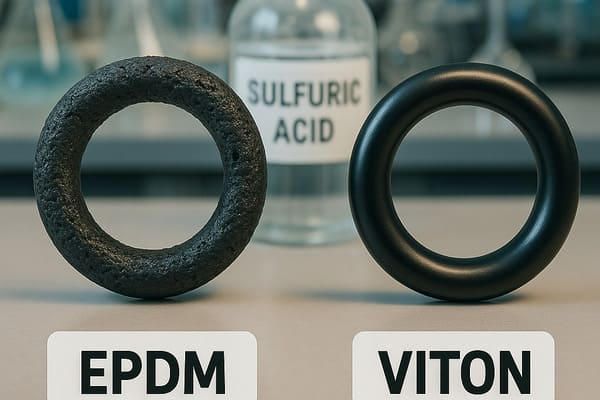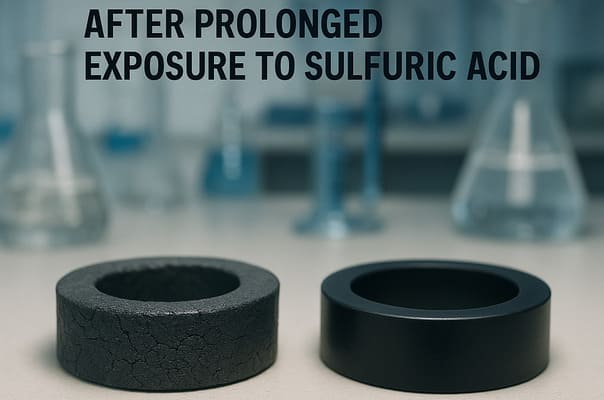Looking for the best rubber material to withstand sulfuric acid exposure? Choosing the right rubber is essential to ensure longevity and performance in harsh chemical environments like those involving sulfuric acid.
The best rubber materials for sulfuric acid resistance are EPDM (Ethylene Propylene Diene Monomer) and Viton (FKM). Both materials offer excellent performance when exposed to sulfuric acid, especially in high concentrations.

Sulfuric acid is a powerful, highly corrosive substance. Selecting the appropriate rubber for applications involving sulfuric acid is crucial to avoid premature material degradation and ensure reliability. Let's explore the best rubber materials for sulfuric acid resistance.
What Is Sulfuric Acid and Why Is It Challenging for Rubber?
Are you curious about why sulfuric acid is so tough on rubber materials? Understanding the properties of sulfuric acid will help you choose the best rubber for your application.
Sulfuric acid is a strong, corrosive chemical used in industries like mining, chemical manufacturing, and metal processing. Its reactivity can degrade many materials, including rubber.

Sulfuric acid (H₂SO₄) is a highly corrosive substance commonly used in various industries such as chemical processing, refining, and automotive. It has strong acidic properties that can break down many materials, including rubber, making it essential to select a rubber material with high chemical resistance1.
When rubber is exposed to sulfuric acid2, it can suffer from degradation such as swelling, softening, cracking, or even complete failure, depending on the concentration and temperature. The acid can attack the polymer chains in the rubber, causing it to lose its structural integrity.
Choosing a rubber with resistance to sulfuric acid is crucial in applications such as seals, gaskets, hoses, and equipment exposed to the chemical. In high concentrations, sulfuric acid can quickly degrade inferior rubber materials3, leading to leaks, failures, and costly downtime.
| Rubber Type | Chemical Resistance to H₂SO₄ | Ideal Applications |
|---|---|---|
| EPDM | Excellent | Seals, gaskets, hoses |
| Viton (FKM) | Very good | Seals, valves, gaskets |
| Nitrile (NBR) | Moderate | General sealing applications |
✅ Why it matters:
Selecting the correct rubber for sulfuric acid exposure ensures the longevity and reliability of components in harsh chemical environments.
Best Rubber Types for Sulfuric Acid Resistance
What are the best rubber materials to withstand sulfuric acid? Let’s examine the most suitable rubber options for acid resistance.
EPDM (Ethylene Propylene Diene Monomer) and Viton (FKM) are the top choices for sulfuric acid resistance. Both offer superior performance, especially in high-concentration applications.

The best rubbers for sulfuric acid resistance are EPDM and Viton (FKM), with each providing distinct advantages depending on the environment and application.
1. EPDM Rubber
EPDM is one of the best options for sulfuric acid exposure4, especially for moderate concentrations. It offers excellent resistance to a wide range of chemicals, including sulfuric acid, and performs well in both high and low temperatures. EPDM also resists ozone, weathering, and aging, which makes it a popular choice for outdoor applications and sealing components.
- Best For: Seals, gaskets, and hoses exposed to low to moderate concentrations of sulfuric acid.
- Limitations: Not recommended for high concentrations of sulfuric acid or extreme temperatures.
2. Viton (FKM) Rubber5
Viton, a fluoroelastomer, excels in resistance to sulfuric acid, even at high concentrations. It can withstand harsh chemicals and high temperatures, making it ideal for more aggressive industrial environments. Its high performance under extreme conditions makes it the preferred choice in industries where sulfuric acid exposure is frequent and intense.
- Best For: Seals, valves, gaskets, and components exposed to high-concentration sulfuric acid.
- Limitations: More expensive than other rubber types.
3. Nitrile Rubber (NBR)6
Nitrile rubber, although commonly used for oil and fuel resistance, can offer moderate resistance to sulfuric acid in lower concentrations. Nitrile rubber is a more affordable option, but it may not perform as well as EPDM or Viton in environments with strong or concentrated sulfuric acid.
- Best For: General sealing applications with low concentrations of sulfuric acid.
- Limitations: Not suitable for high-concentration or prolonged exposure.
| Rubber Type | H₂SO₄ Resistance | Best Application | Temperature Range |
|---|---|---|---|
| EPDM | Excellent | Seals, hoses, gaskets | -50°C to +150°C |
| Viton (FKM) | Very good | High-temp seals, valves | -20°C to +250°C |
| Nitrile (NBR) | Moderate | General sealing | -30°C to +100°C |
✅ Why it matters:
Choosing the appropriate rubber material for sulfuric acid ensures the durability and reliability of industrial components, reducing the risk of leaks and failures.
How to Choose the Right Rubber for Sulfuric Acid?
Wondering how to select the best rubber for sulfuric acid? Let’s break down the most important considerations when making this decision.
To choose the right rubber, consider factors like acid concentration, temperature, and exposure duration. EPDM and Viton are the best choices for most sulfuric acid applications.
When selecting the best rubber for sulfuric acid exposure, there are several important factors to consider:
- Concentration of Sulfuric Acid: Higher concentrations of sulfuric acid require more resistant materials like Viton7, while lower concentrations can be managed with EPDM8.
- Temperature: For high-temperature applications, Viton provides superior resistance, making it the best choice for environments where heat is a factor.
- Exposure Duration: Extended exposure to sulfuric acid can degrade rubber faster, so it's important to choose materials with strong long-term resistance.
- Specific Application: Whether you need seals, hoses, or gaskets, the type of rubber chosen should be suitable for the mechanical stress, temperature, and chemical exposure involved in your application.
Key Factors to Consider When Choosing Rubber for Sulfuric Acid:
| Factor | Best Rubber Choices | Key Considerations |
|---|---|---|
| Acid Concentration | EPDM, Viton (FKM) | Higher concentrations need Viton |
| Temperature | Viton (FKM), EPDM | Viton for high-temperature tolerance |
| Exposure Duration | EPDM, Viton (FKM) | Longer exposure needs more resistant materials |
| Application Type | EPDM, Viton (FKM), Nitrile | Choose based on specific component needs |
✅ Why it matters:
By considering these factors, you can ensure that the rubber you select will provide optimal performance and durability in your sulfuric acid applications.
Conclusion
When dealing with sulfuric acid, selecting the right rubber material is crucial for ensuring long-term durability and performance. EPDM and Viton are the top choices, with EPDM suitable for moderate concentrations and Viton for high-concentration and high-temperature environments. By considering factors like concentration, temperature, and exposure duration, you can ensure that your rubber components stand up to the challenges posed by sulfuric acid.
🚀 Need Custom Rubber Solutions for Your Industrial Needs?
Contact Julong Rubber today or Request a Custom Quote for high-quality rubber components tailored to your specifications!
Or reach out to us directly via WhatsApp:
Learn about selecting materials with chemical resistance to enhance safety and durability in industrial settings. ↩
Explore the diverse uses of sulfuric acid in industries to understand its significance and impact. ↩
Discover the best rubber materials for chemical resistance to ensure reliability in harsh environments. ↩
Explore this link to understand the best materials for handling sulfuric acid, ensuring safety and durability in industrial applications. ↩
Learn more about Viton (FKM) Rubber, its unique properties, and why it's preferred in harsh chemical environments. ↩
Discover the properties of Nitrile Rubber (NBR) and its applications, especially in low concentration sulfuric acid environments. ↩
Explore the unique properties of Viton, a top choice for sulfuric acid exposure, to ensure optimal performance in your applications. ↩
Learn about EPDM's resistance to sulfuric acid and its suitability for various applications, ensuring you make an informed choice. ↩








